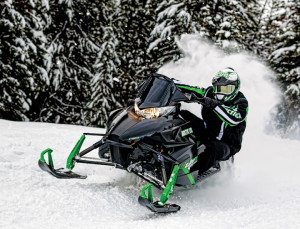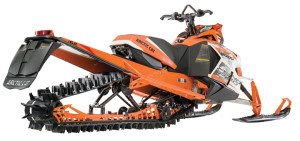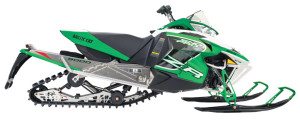Arctic Cat sleds gain new engine, lose weight
High-tech two-stroke, heritage names for ’14 lineup
With its first self-made snowmobile engine, the big news for Arctic Cat snowmobile dealers and customers in 2014 is the addition of a direct-injected 600cc two-stroke engine that meets the Environmental Protection Agency’s more stringent 2012 emissions standards.
Arctic Cat’s M Series mountain sleds have shed a significant amount of weight for the upcoming model year, the XF crossover lineup has expanded and, of course, there are several new ProCross and ProClimb models powered by Yamaha’s 1,049cc four-stroke Genesis engine as part of the recently announced cross-brand partnership.
If that wasn’t enough headline-grabbing news, two of the company’s heritage model names have been resurrected as part of a new snowmobile branding effort.
High-tech two-stroke
With the EPA’s 2012 standard looming, Arctic Cat was forced to cut its previous Suzuki-sourced 600 two-stroke twin in order to meet the government-mandated fleet average. The new in-house engine, manufactured at its St. Cloud, Minn., plant, restores Cat as a player in one of the most significant engine classes in the snowmobile industry and moves the company closer to a future without its long-standing engine supply agreement with Suzuki.
Dubbed the 6000-series C-TEC2, the new engine’s crankcase, crankshaft, cylinders, pistons, head and reed valves all were designed in-house. Its bore/stroke (73.9mm x 70mm) and displacement (598.9cc) exactly match the previous 600, although it’s an all-new design with fundamental dimensions Arctic Cat wanted to replicate.

Weighing 10 pounds less than the Suzuki it replaces, which powered F6 models through 2010, the new direct-injected engine has a significantly lighter crankshaft, glass fiber reed petals positioned in a “double V” pattern for longer engine life and a unique fuel injection system. With one injector per cylinder, fuel is injected in two states. Under low engine loads, the system shoots fuel directly into the combustion chamber between the piston dome and cylinder head. When loads increase, fuel begins to spray sooner, when the piston is at top-dead center, through a slot in the side of the piston. Injectors are positioned in the cylinder wall.
Other unique features include an electronic oil pump that flows oil based on the engine’s current needs by sensing throttle position, RPM and altitude. To lubricate the top end, fuel is mixed with oil in the fuel rail so it can be injected on the piston pin bearing. With a laydown design, and air intake and exhaust on the front of the engine, Arctic Cat claims the new C-TEC2 has an exceptionally strong crankcase.
“The C-TEC2 600 was designed to deliver class-leading horsepower (123 hp), be lighter than our previous 600 two-strokes and deliver great fuel and oil consumption while meeting the current emissions standards,” said Arctic Cat media relations specialist Kale Wainer. “Starting with a clean-sheet design, the 600 DSI engine will pave a path for our future, and the profitability will follow.”
For 2014, the new 600 two-stroke will be available only in one model, the trail-focused ZR 6000 El Tigre, heralding the return of two heritage names in one model.

To counter the successful Polaris 600 RMK entry-level mountain sled, some expected Cat to introduce its new 600 two-stroke to the mountain segment. When asked why it didn’t, Wainer said the company’s engineers have been extremely busy introducing 10 new models and the new engine, but added that it’s possible to see the C-TEC2 expanded to additional models.
“Not only did we commit to designing and building our own, all-new, Clean Technology 600 C-TEC2 engine, we also purchased the 1,056cc four-stroke engine from Yamaha that is in our 7000 Series models,” Wainer said. “Building these 10 new models took a considerable amount of time and we are committed to producing these models as front-runners straight off the production line.”
New Cat vernacular
Reaching back into Arctic Cat’s history, El Tigre is a name plucked from the 1970s and 1980s, while ZR was affixed to its trail sleds throughout the 1990s and early 2000s. It’s part of an entirely new naming structure primarily denoted by engine size: 5000 Series for the 1,100cc naturally aspirated four-stroke twin; 6000 for the new twin-cylinder 598.9cc two-stroke; 7000 for the Yamaha-sourced 1,049cc three-cylinder; 8000 for the 794cc two-stroke twin and 9000 for the turbocharged 1,100cc four-stroke twin.
Those numerical designations will be paired with the letter M for Arctic Cat’s mountain sleds, XF for crossover models and ZR will replace the F models in ProCross-based trail sleds. LXR, Sno Pro and Sno Pro Limited will still be used for specific packages within the model lines.

“The ZR proved all but unbeatable in the hands of Team Arctic racers, and was equally appreciated by trail riders, becoming an instant hit on the showroom floor. Every season of the ZR produced notable breakthrough changes in chassis, suspension and engine technology,” Wainer said. “The new Arctic Cats in the ProCross and ProClimb chassis mimic the ZR history, so it was only fitting to reintroduce the infamous ZR name.”
M Series tweaks
After dropping the naturally aspirated 1100 four-stroke from its M Series mountain line, the 177 hp 9000 Series C-TEC4 four-stroke turbo and 160 hp 8000 Series two-stroke will be the sole engine choices. In total, there are 12 Arctic Cat M Series models for 2014.
Other M changes include new ergonomics, a tweaked suspension to improve off-trail and hill-climb performance, and all 800cc models get a new driveshaft, driveshaft sprockets, aluminum lower gear and lightweight brake disc with the race-edition hydraulic brake for better braking performance.
Weight was also shed from the ProClimb chassis with aluminum chassis spars instead of steel, a shorter HCR heat exchanger, aluminum axles in the skid frame, lighter shock bushings, smaller suspension hardware and a shorter seat. Altogether, Arctic Cat claims its M8000 models lost a significant 20 pounds. M9000 Turbo models shed 5 pounds as a result of the new driveshaft, rear suspension hardware and axles.








